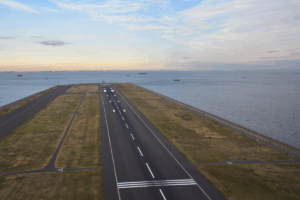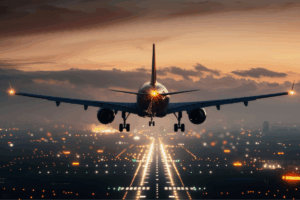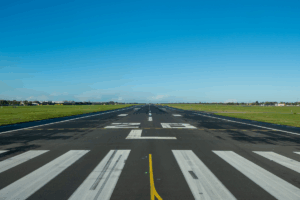System upgrades are often necessary for most forms of technology, including runway lights. Making informed lighting system choices not only helps keep your runways operating safely and efficiently, but they also open up your airport to additional revenue and expansion opportunities.
In this month’s blog, we discuss five key considerations we believe should drive your purchasing decisions.
Consider Only The Lighting Types You Need
There is no one-size-fits-all solution for airport runway lighting. Each system is based on the specific needs and configuration of the individual airport. With all the different types of airport runway and taxiway lighting available, it’s essential to understand which ones you need.
For example, large airports with multiple runways and taxiways that operate 24 hours per day will usually require a robust and complex system that features runway edge lights, centerline lights, threshold lights, and touchdown zone lights. Safe ground movement at runway/taxiway intersections and along the taxiway can also be achieved with taxiway edge lights, centerline lights, runway guard lights, and stop bar lights.
Operators of large airports should also consider apron lighting to provide safe guidance of aircraft when parking or moving at gates, as well as illuminated airfield signs to offer directional information to pilots.
Smaller regional and rural airstrips that operate only during the day, have a single runway, or are designed to handle only small aircraft, won’t need the comprehensive setup required at larger airports. However, upgrade plans should consider future growth objectives to facilitate expansion more easily when the time comes.
Adopting Advanced LED Technology
Although some airports still use halogen lights on their runways and taxiways, we’re currently in the age of LED, and there are no signs of it going away. If you haven’t yet upgraded to LEDs, you should seriously consider doing so, especially since halogen lamps are becoming scarce and harder to obtain. Most manufacturers, such as GE and Osram, aren’t making halogen lamps anymore, so the time to upgrade is now.
The good news is that there are almost no downsides to switching to LEDs. They are the gold standard of lighting technology due to the many benefits they bring to airport operators. They last longer than other bulbs, consume less energy, and require less frequent maintenance, all of which add up to significant cost savings you can use to innovate in different areas of your airport.
However, LEDs aren’t just about cutting costs. They provide powerful, reliable illumination that enhances the safety of your air traffic and ground movement operations, making them the most obvious choice for modern airports looking to increase efficiency, boost revenue, and minimize their environmental impact through LED’s advanced energy efficiency.
Read More: How LED Technology Had Revolutionized The Airport Lighting Industry
Maintenance Requirements Of The Lighting Equipment
Your lighting system will require a regular maintenance program to keep it operating reliably. Additional maintenance measures must be taken in areas that see heavy snowfall to ensure safe and consistent airport operations throughout the year.
As mentioned, LED technology requires much less maintenance than other types of lighting and requires fewer changes over its lifetime. Your airport runway lighting supplier can advise on the maintenance needs of any system you’re considering so you can make an informed choice that falls within your maintenance budget.
Read More: Maintenance Routines For Inset Runway And Taxiway Lighting
Compliance With Regulatory Guidelines
Naturally, any runway lighting systems you purchase and install must comply with international safety regulations to ensure your airport is safe for pilots, passengers, air and ground crews, airport personnel, and other stakeholders using your facilities.
For example, the International Civil Aviation Organization (ICAO) and the Federal Aviation Administration (FAA) have established strict guidelines for airfield lighting systems that all airport operators must comply with. There are also local regulations that must be adhered to.
Your airport supplier can help ensure that your system upgrades are fully compliant with all relevant governing bodies that oversee your geographic location.
Return On Investment Of Upgrading Your Lighting System
Few things stop an upgrade project cold quicker than seeing its initial costs. In the case of runway lighting systems, it’s essential to take a long-term view to appreciate the return on your initial investment.
For example, although your upfront cost may be high, the money you save in lower energy usage, reduced downtime,and less frequent maintenance all add up to a significantly improved bottom line over subsequent years. Bigger profits can lead to more innovation, further optimizing your operation to attract more carriers, more flights, and, consequently, more revenue.
Airport Lighting Company: Your Trusted Partner In New System Installations And Upgrades
It’s critical to have a seasoned professional on your side when making purchasing decisions for your runway lighting infrastructure. The expert engineers at Airport Lighting Company will gladly collaborate with your technical teams to develop a cost-effective solution that meets your current needs and delivers significant energy and maintenance savings over the long term.
Consider us your trusted partners in airport runway safety and efficiency. We’ve been helping connect airport operators with cost-effective solutions since 1967, and we’re ready to help take your airport runway infrastructure deeper into the century with advanced technology solutions you can rely on.
Call Airport Lighting Company for the latest in airport lighting technology
The Airport Lighting Company team is standing by to answer your questions about how our tech-based products can help improve the safety, reliability, and efficiency of your runways. Call 315-682-6460 for fast, friendly service you can count on.


